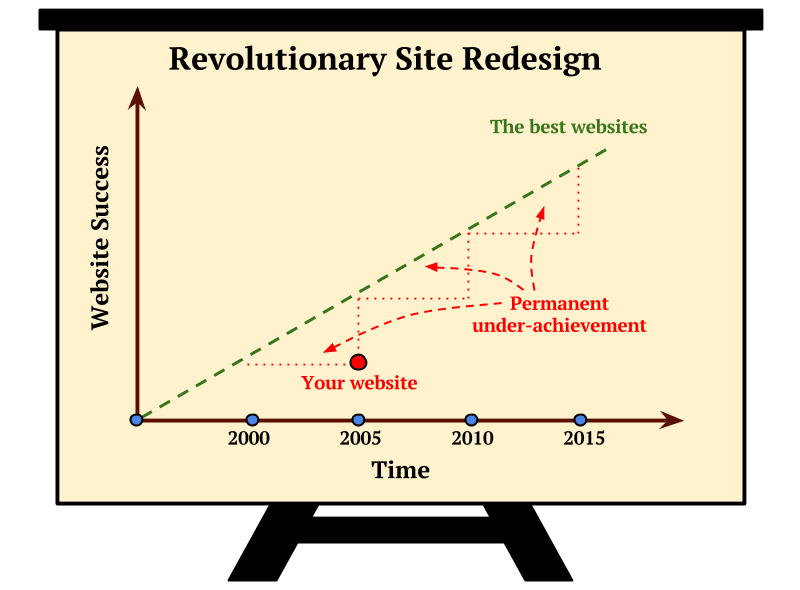Evolutionary Site Redesign vs Revolutionary Site Redesign

Those who monitor trends in the field of web design on regular basis know that evolutionary site redesign (ESR) beats revolutionary (RSR) approach on every level in 99% of cases. The rest 1% is left for truly outdated websites with serious lack of design and standards that require building from scratch.
Why site redesign is necessary?
Some of the most frequent responses would be:
- Our competitors has redesigned their website.
- Management wants their site to be responsive.
- The CEO said so!
- We have not done a site redesign for X years...
Each of these responses is essentially wrong, without a basic understanding of the present website in terms of its functionality, design, optimization, statistics, bounce rate, number of visits and other relevant factors.
The key answer is actually simple: one should invest in its web site if after a certain amount of time the website itself is able to return the money invested.
Speaking of investment, it is very important to distinguish the site’s main purpose, whether it is a personal web site, the local association, a musical band, alumni, university, company, media company or online store. The first would just like to have a bit of praise or ego-trip, without any other meaningful purpose, and the latter would want to convert every visit into purchase.
At the beginning of each year there are planty of blogs and sites to notice web design trends which are then blindly adhere to all. To be honest, this trend is mostly dictated by the world's leading companies and services. The common goal of all more or less innovative solutions is to make the visitor feel comfortable and to provide clear call-to-action input.
5 reasons why Revolutionary Site Redesign fails

RSR is expensive
The redesign process requires more people i.e. a team of experts who would work on the project. Their involvement is not cheap, regardless they are being paid per hour or per project.
RSR is time consuming
The more complex website is - the longer would be the redesign process, and during all that time your site remains unchanged.
RSR undermines Search Engine Optimization
There are countless examples that after the redesign process and drastic changes in the core site structure, search engine visibility drops significcantly, together with site ranking. The most common reasons are disturbed URI links, as well as inbound links. Another problem is the integration of trendy services and scripts, especially those related to the social networking sites. If not done properly, additional 3rd party applications can cause longer pageload and other problems.
RSR will not follow trends in the long run
Even if a client finds a best-buy offer for a site redesign project, there is no way to determine how it will be reflected in your business success. It may be that completely out of style even after a few months, it can significantly decrease the number of visits, and therefore profit, if it is a website that promotes a particular group of products or services.
RSR can drive away visitors
When "overdone" with changes, it is not rare that a number of regular visitors simply leave the site, never come back and leave happily ever after.
What is the main advantage of ESR above RSR?
If we had to choose just one answer, let it be measurability.
Performing gradual micro-changes on the site, with adequate A/B testing, marketeers can accurately measure all effects the site yields on the performance and visitor behavior.
Constant improvements are the right way to keep site optimized, juicy-fresh, eye-catchy and up-to-date. Small changes of individual elements can be performed with more ease and less time. Some will probably say that it still costs money, which is true, but for a profitable site this is incomparably cheaper compared to hiring an entire team of experts. If these changes become frequent enough, management should consider permanent engagement of an in-house site designer.
What can be redesigned on a site?
Shortly speaking, everything can be redesigned! To name just a few basic things: logo design and position, font type and size, navigation, structure, form elements design and size, images, section layout...
There are also many things that can not be seen at the first glance:
- keyword optimization,
- code optimization and verification,
- faster pageloading etc...
5 Main Reasons for Evolutionary Site Redesign

Some people might find frustrating that after a serious site redesign developed according to all modern standards most clients still won’t be 100% satisfie. The fact is there is always planty of room for improvement there, and as soon as a client is reconciled with that, any further improvement will be less stressful.
If there is still a dilemma for why the Evolutionary Site Redesign is clearly better than the Revolutionary Site Redesign, these are the four most striking reasons:
- ESR brings new, fresh appearance of the site
- ESR is and faster and more effective than the RSR
- Choosing ESR over RSR is strategic, cost-effective desicion
- Using ESR approach it is more comfortable to monitor trends and keeping up the pace with current standards
- ESR leaves enough time to focus on analytics tracking instead of design flaws
If possible, before any major redesign decision, one should always check whether the proportional financial investment in marketing activities and promotion of the existing site would have more effect than a single investment in a new look, or what would be the greater risk for the client.
